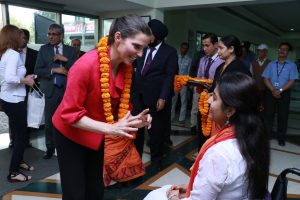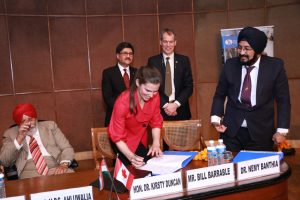IC-IMPACTS (Canada), RHI (now Praxis Spinal Cord Institute, Canada), and ISIC (India) have partnered to launch a grant competition to fund innovation and research in the treatment and care of people living with Spinal Cord Injury (SCI) and secondary complications in India and around the world.
 In Canada, 86,000 people live with SCI, which costs an estimated $2.7 billion per year in health and associated care and also historically leads to mortality rates two to five times higher than for people with no SCI. For under-resourced and more populous nations like India, millions affected by SCI have a poorer prognosis and fewer available supports.
In Canada, 86,000 people live with SCI, which costs an estimated $2.7 billion per year in health and associated care and also historically leads to mortality rates two to five times higher than for people with no SCI. For under-resourced and more populous nations like India, millions affected by SCI have a poorer prognosis and fewer available supports.
The competition seeks to attract innovators, medical practitioners and researchers in Indian and Canadian universities/institutes to work collaboratively across borders, develop and commercialize innovative technologies in the treatment and care of people who are living with SCI and associated secondary complications.
 Following the February 2018 visit in New Delhi of the Honourable Kirsty Duncan during Prime Minister Justin Trudeau’s visit to India, an agreement was signed by IC-IMPACTS, the Rick Hansen Institute (RHI), and the India Spinal Injuries Centre (ISIC) to develop a grant competition that will bring about innovative solutions in the treatment and care of millions of people in India and Canada who live with SCI and secondary complications. The grant (Canada-India SCI Innovation Award – Getting Solutions to Market) will be awarded in December 2018 in New Delhi.
Following the February 2018 visit in New Delhi of the Honourable Kirsty Duncan during Prime Minister Justin Trudeau’s visit to India, an agreement was signed by IC-IMPACTS, the Rick Hansen Institute (RHI), and the India Spinal Injuries Centre (ISIC) to develop a grant competition that will bring about innovative solutions in the treatment and care of millions of people in India and Canada who live with SCI and secondary complications. The grant (Canada-India SCI Innovation Award – Getting Solutions to Market) will be awarded in December 2018 in New Delhi.
SCI is a medically complex condition associated historically with very high mortality rates. The prognosis for people with SCI can vary widely depending on a country’s economic status. In high-income countries, with the availability of new techniques, facilities, and proper utilization of resources, people with SCI can now anticipate longer, fuller, and more productive lives. In low-income countries, traumatic SCI can be a terminal condition. In the past, the availability of resources was limited: medical and rehabilitation services were minimal and there were few opportunities for community and social participation. However, the situation is changing in India with newly available resources and medical facilities such as the Indian Spinal Cord Injuries Centre (ISIC). With the right collaborative arrangements and use of resources, it should be possible for people with SCI to live, thrive, and achieve fuller, more productive lives.
A recent survey confirmed that international collaboration can have a positive impact with technology or knowledge transfer and commercialization from high- to low-income countries, resulting in seven of the top 10 barriers in SCI modified by an international initiative.
An example of a successful international collaboration between researchers from high- and low-income countries is a joint collaborative program with the University of Pittsburg, USA and Human Engineering Research Lab, Department of Biotechnology (Government of India) at the Indian Spinal Injury Centre, New Delhi, India. This project resulted in the development of a low-cost motorized wheelchair (LOCOMO-WC) that was designed to meet the needs of individuals in low resource settings (Press release dated January 28, 2016, from the Ministry of Science & Technology, Government of India—Make-in-India initiative: Inauguration of low-cost motorized wheelchair [PDF]).
Title: Canada India SCI Innovation Award – Getting Solutions to Market:
An amount equivalent and up to CAD $50,000* will be granted to the successful proposal(s) for research and development. This amount may be supplemented by cash or in-kind support by host institutes or other agencies associated with the researchers.
* If GST is applicable, the award amount will be reduced to include GST. For example, a $50,000 award might be reduced if the maximum GST (18%) is applied; it would change the amount of the award to $42,372.88 + 18% GST. A concessional GST rate of 5% may apply in qualifying cases.
The objectives of the innovation competition are to:
18 to 24 months
The competition will seek to fund proposals in three categories in the deployment-ready stage of development related to spinal cord injury (SCI) prevention and management (treatment & support).
These may include:
IC-IMPACTS Centres of Excellence is a not-for-profit organization, established by the Federal Government of Canada through the Centres of Excellence Program to serve as a pan-Canadian agency responsible for the delivery of research programs in the areas of sustainable infrastructure, integrated water management, and public health, disease prevention, and treatment between Canada and India. IC-IMPACTS is the only Networks of Centres of Excellence (NCE) with a mandate focused on research collaborations between Canada and India.
RHI (Rick Hansen Institute) is a Canadian-based not-for-profit organization that drives innovation in spinal cord injury research and care. RHI strives to improve the lives of people living with SCI in Canada and around the world. RHI is committed to accelerating the translation of discoveries and best practices into improved treatments for people with spinal cord injuries. Headquartered in Vancouver, BC, RHI facilitates an international network of researchers, healthcare professionals, entrepreneurs, investors, and people with SCI and their supporters in order to find solutions to one of the most debilitating, costly and life-altering health conditions.
ISIC (Indian Spinal Injuries Centre) is the most advanced Spine, Orthopedic and Neuromuscular Surgical centre in India with the latest state of the art diagnostics and surgical equipment and a highly qualified team of specialists recognized internationally who have been trained in leading institutes of India and abroad. Indian Spinal Injuries Centre provides state of the art facilities for the management of all types of spinal ailments. The goal is to reach the lives of thousands of newly spinal injured every year by providing medical excellence through scientific expertise and to optimize self-sufficiency and independence for the rehabilitation patient.
1. Indian applicants:
All Indian researchers normally eligible to apply for DST/ICMR funding opportunities are eligible to apply as Principal Investigators from India.
Subject to the following guidelines, we also welcome proposals from NGOs, graduate students, medical practitioners, entrepreneurs, and for-profit corporate entities who have a proven track record in the care and treatment of Spinal Cord Injuries and secondary complications:
a. NGOs, graduate students, medical practitioners, and entrepreneurs: These applicants are not expected to make a cash contribution.
b. For-profit corporate entities: For-profit organizations such as industries or corporations will be expected to make a cash contribution and, if successful, will receive matching funding. For example, a medical equipment manufacturer that aims to assess the effectiveness of new processes or innovations can submit a letter of intent; if successful, they will receive matching funding from the grant.
2. Canadian applicants:
All Canadian researchers normally eligible to apply for DST/ICMR funding opportunities are eligible to apply as Principal Investigators from Canada.
Subject to the following guidelines, we also welcome proposals from NGOs, graduate students, medical practitioners, entrepreneurs, and for-profit corporate entities who have a proven track record in the care and treatment of Spinal Cord Injuries and secondary complications:
a. NGOs, graduate students, medical practitioners, and entrepreneurs: These applicants are not expected to make a cash contribution.
b. For-profit corporate entities: For-profit organizations such as industries or corporations will be expected to make a cash contribution and, if successful, will receive matching funding. For example, a medical equipment manufacturer that aims to assess the effectiveness of new processes or innovations can submit a letter of intent; if successful, they will receive matching funding from the grant
Please note following important application instructions:
The research project funded in this call is expected to lead to a technology or solution directly impacting the lives of Indian and Canadian citizens.
India-Canada joint projects must be based on meaningful stakeholder engagement, include a common project plan, a realistic budget, and involve at least one researcher from Canada and one researcher from India. Student and HQP (Highly Qualified Professional) training is a mandatory component of all funded projects.
Letters of Intents submitted for funding through this call will be evaluated against the following selection criteria:
The funded project participants shall agree upon the ownership, access rights, and exploitation of the intellectual property generated during the cooperation. The agreements shall be made in writing. The guidelines of the funding organizations should be followed when making the agreements. At a minimum, a letter of intent between the collaborators should be included in the application stating the desire for cooperation and acknowledging that each participant has understood the general terms and conditions of the other project parties.
For Indian participants:
Indian Spinal Injuries Centre
Sector C, Vasant Kunj, New Delhi, India
For Canadian participants:
Email: [email protected]
To apply, please download and complete the following documents:
In addition, please ensure you submit the following with your letter of intent:
Thank you for submitting your applications! This call for proposals is now closed.